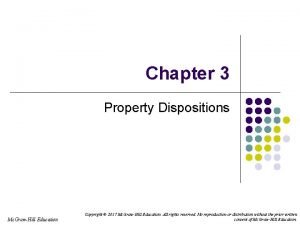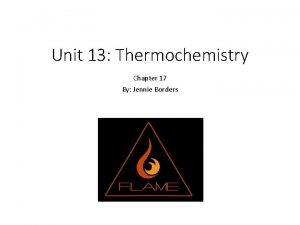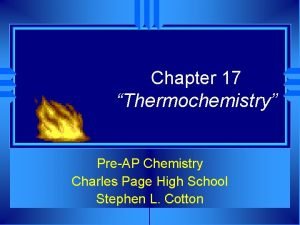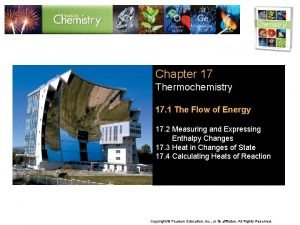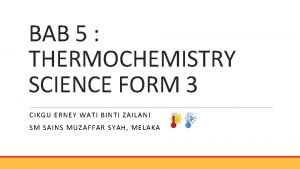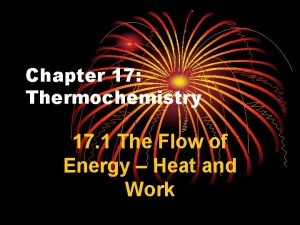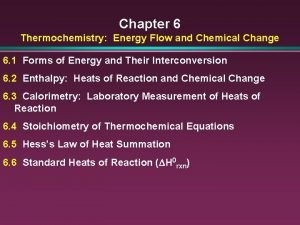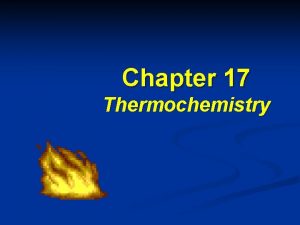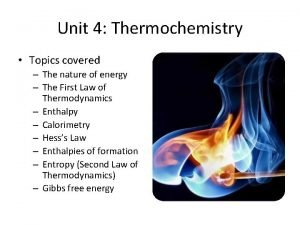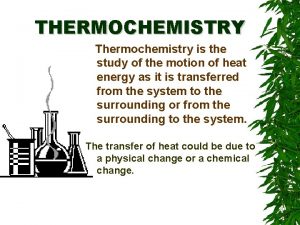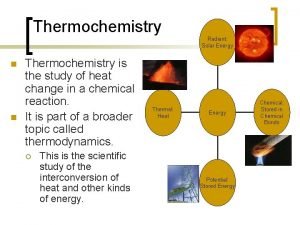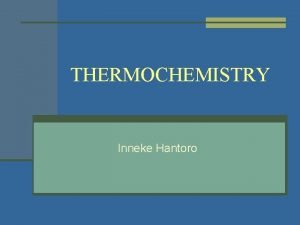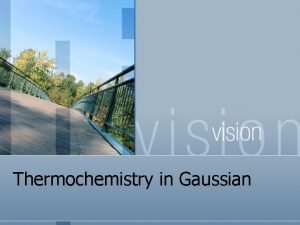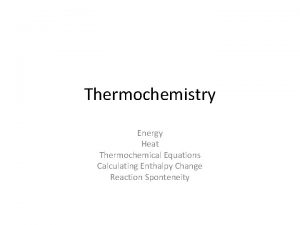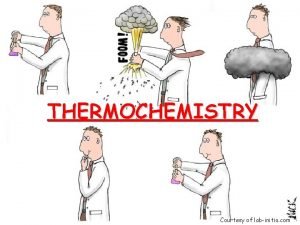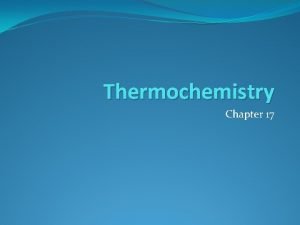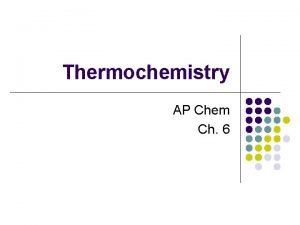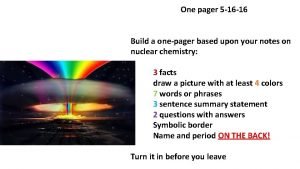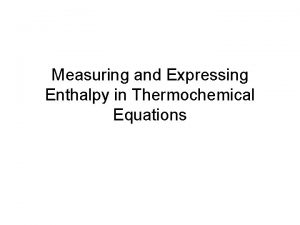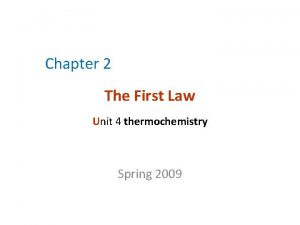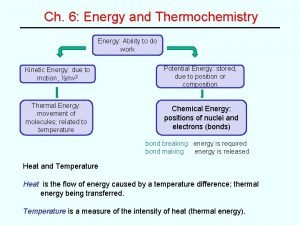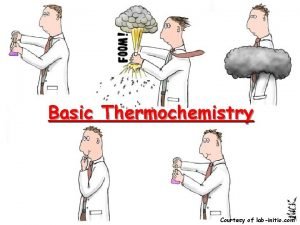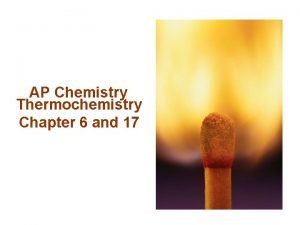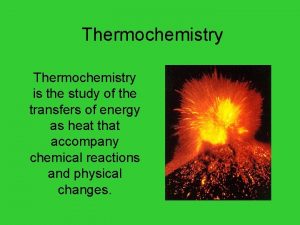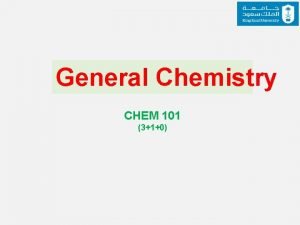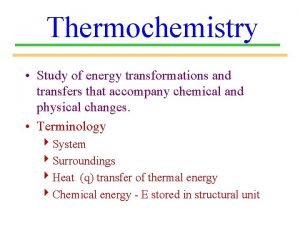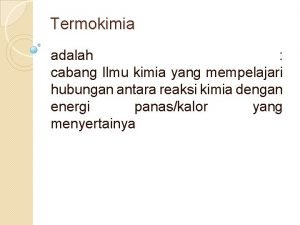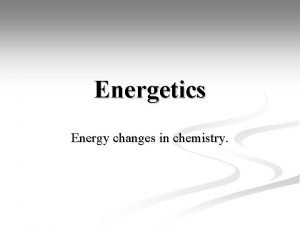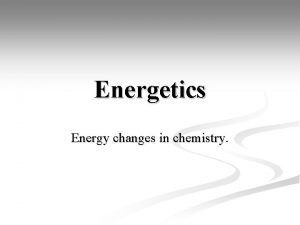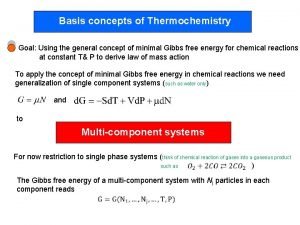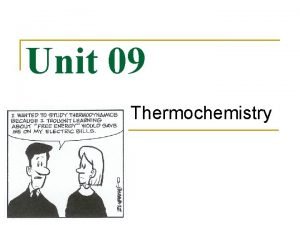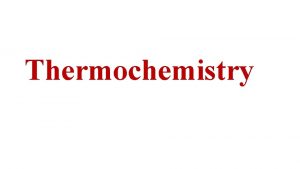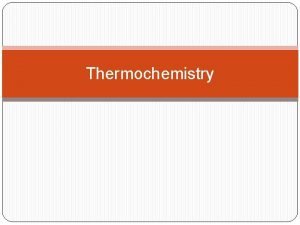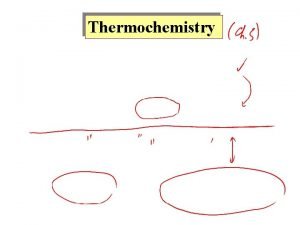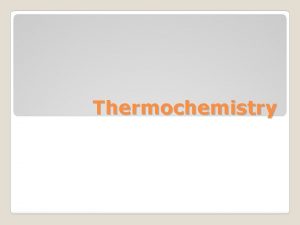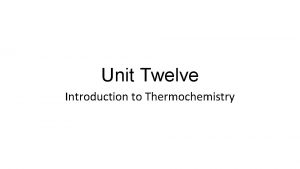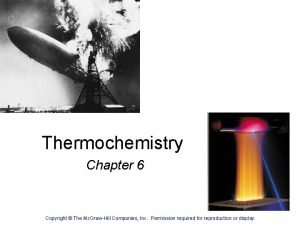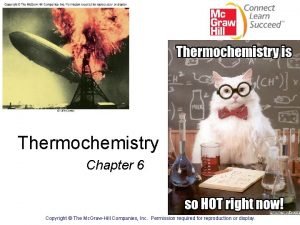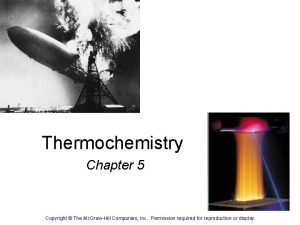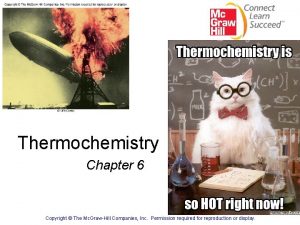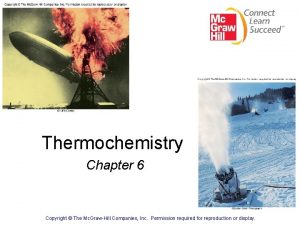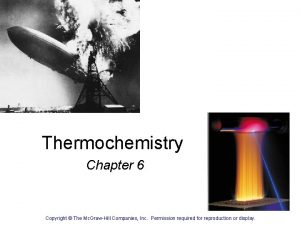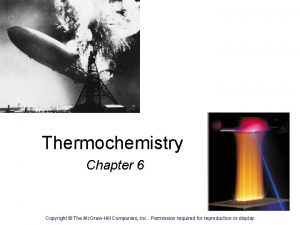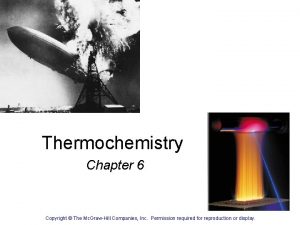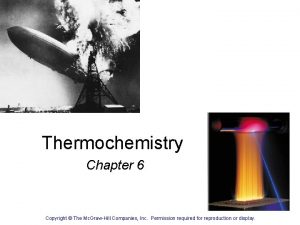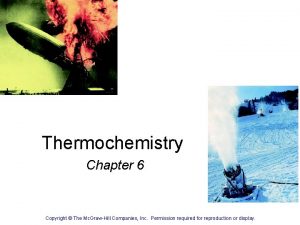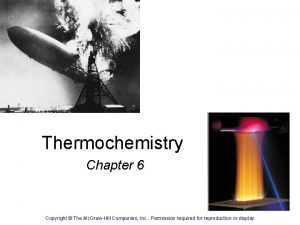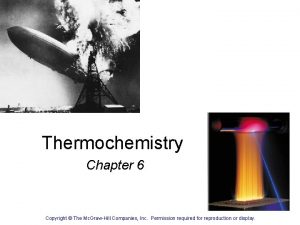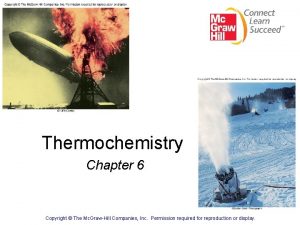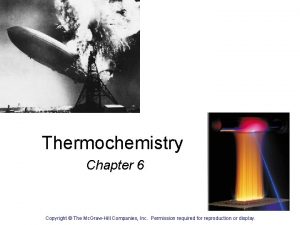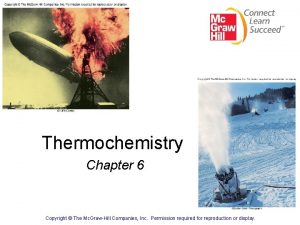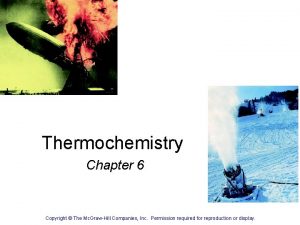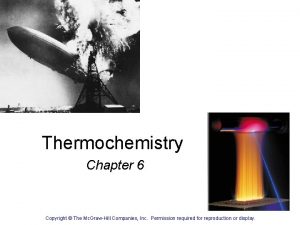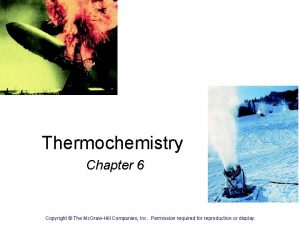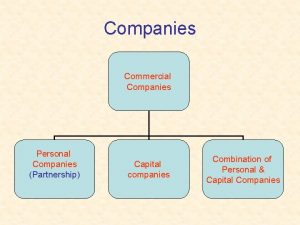Thermochemistry Chapter 6 Copyright The Mc GrawHill Companies















































- Slides: 47

Thermochemistry Chapter 6 Copyright © The Mc. Graw-Hill Companies, Inc. Permission required for reproduction or display.

Energy is the capacity to do work. • Radiant energy comes from the sun and is earth’s primary energy source • Thermal energy is the energy associated with the random motion of atoms and molecules • Chemical energy is the energy stored within the bonds of chemical substances • Nuclear energy is the energy stored within the collection of neutrons and protons in the atom • Potential energy is the energy available by virtue of an object’s position 2

Energy Changes in Chemical Reactions Heat is the transfer of thermal energy between two bodies that are at different temperatures. Temperature is a measure of thermal energy. Temperature = Thermal Energy 3

Thermochemistry is the study of heat change in chemical reactions. The system is the specific part of the universe that is of interest in the study. open Exchange: mass & energy closed isolated energy nothing 4

Examples • Open systems – The ocean and the atomosphere – A mug of a hot drink with an open top • Closed systems – Air inside of a balloon – A corked bottle of liquid • Isolated systems – A thermos of tea 5

Exothermic process is any process that gives off heat – transfers thermal energy from the system to the surroundings. 2 H 2 (g) + O 2 (g) 2 H 2 O (l) + energy H 2 O (g) H 2 O (l) + energy Energy is a product Endothermic process is any process in which heat has to be supplied to the system from the surroundings. energy + 2 Hg. O (s) 2 Hg (l) + O 2 (g) energy + H 2 O (s) H 2 O (l) Energy is a reactant 6

Examples • Exothermic processes – Chemical hot packs (hand warmers) – Explosions – Most combustion proceses – Rusting iron • Endothermic – Cooking an egg – Melting ice – Chemical cold packs (ammonium nitrate in water) 7

Parameters and Units that characterize Gases Recall units: Mass = amount of material = g, kg, mg, lbs, oz Molar mass = a. m. u. or g/mol Moles = mass / molar mass = mol Volume = space occupied = m. L, L, cm 3, in 3, ft 3 Density = mass / volume = g/m. L, g/L Temperature = 0 C, 0 F, and K Pressure = force per unit area = psi, lbs/ in 2 mm. Hg, torr, atm, Pa, k. Pa STP: Standard Temperature and Pressure= specified values for gases Std. T = 0 0 C = 273 K Std. P = 1 atm = 760 mm. Hg = 760 torr = 101, 325 Pa for Thermochemistry: Std. T = 25 0 C = 298 K Std. P = 1 atm = 760 mm. Hg = 760 torr = 101, 325 Pa IMPORTANT: Know what these units measure; know how to use them for conversion; know the specific values for STP 8

Physics Relationships: Speed => velocity = distance /time v = d/t Change in speed => acceleration = (v 2 -v 1)/(t 2 -t 1) Force due to motion => force = mass x acceleration f = ma Force on a surface => pressure = force/area P = f/A Units: f = kg*m/s 2 = Newton 1 N = 1 kg*m/s 2 P = kg*m/s 2 = Pascal m 3 1 Pa = 1 kg*m/s 2 = 1 N/m 2 m 3 9

Physics Relationships (continued): Energy => work done = force x distance w=fxd due to work Units of Energy: W = (kg*m/s 2) x m 1 Joule = kg*m 2 /s 2 And since 1 N (Newton)= kg*m/s 2 1 J = 1 N*m Energy => Kinetic energy = KE = 1/2 mv 2 use u for particles in motion KE = 1/2 mu 2 Units of heat will be in Joules or calories 10

Enthalpy (H) is used to quantify the heat flow into or out of a system in a process that occurs at constant pressure. DH is a measured quantity = heat given off or absorbed during a reaction at constant pressure DH = H (products) – H (reactants) Is DH negative or positive? System absorbs heat System gives off heat Endothermic Exothermic DH > 0 DH < 0 Write a thermochemical equation for : A. 6. 01 k. J are absorbed for every 1 mole of ice that melts at 00 C and 1 atm. (physical change) B. 890. 4 k. J are released for every 1 mole of methane that is combusted at 250 C and 1 atm. (chemical change) 11

Thermochemical Equations Is DH negative or positive? System absorbs heat Endothermic DH > 0 6. 01 k. J are absorbed for every 1 mole of ice that melts at 00 C and 1 atm. (physical change) H 2 O (s) H 2 O (l) DH = 6. 01 k. J/mol 12

Thermochemical Equations Is DH negative or positive? System gives off heat Exothermic DH < 0 890. 4 k. J are released for every 1 mole of methane that is combusted at 250 C and 1 atm. (chemical change) CH 4 (g) + 2 O 2 (g) CO 2 (g) + 2 H 2 O (l) DH = -890. 4 k. J/mol 13

Thermochemical Equations • The stoichiometric coefficients always refer to the number of moles of a substance H 2 O (s) H 2 O (l) • If you reverse a reaction, the sign of DH changes H 2 O (l) H 2 O (s) • DH = 6. 01 k. J/mol DH = -6. 01 k. J/mol If you multiply both sides of the equation by a factor n, then DH must change by the same factor n. 2 H 2 O (s) 2 H 2 O (l) DH = 2 x 6. 01 = 12. 0 k. J 14

Thermochemical Equations • The physical states of all reactants and products must be specified in thermochemical equations. H 2 O (s) H 2 O (l) DH = 6. 01 k. J/mol H 2 O (l) H 2 O (g) DH = 44. 0 k. J/mol How much heat is evolved when 266 g of white phosphorus (P 4) burn in air? P 4 (s) + 5 O 2 (g) P 4 O 10 (s) DH = -3013 k. J/mol 15

Thermodynamics is the scientific study of the interconversion of heat and other kinds of energy. State functions are properties that are determined by the state of the system, regardless of how that condition was achieved. energy, pressure, volume, temperature DE = Efinal - Einitial DP = Pfinal - Pinitial DV = Vfinal - Vinitial DT = Tfinal - Tinitial Potential energy of hiker 1 and hiker 2 is the same even though they took different paths. 16

First law of thermodynamics – energy can be converted from one form to another, but cannot be created or destroyed. DEsystem + DEsurroundings = 0 or DEsystem = -DEsurroundings C 3 H 8 + 5 O 2 3 CO 2 + 4 H 2 O Exothermic chemical reaction! Chemical energy lost by combustion = Energy gained by the surroundings 17 system surroundings

Another form of the first law for DEsystem DE = q + w DE is the change in internal energy of a system q is the heat exchange between the system and the surroundings w is the work done on (or by) the system w = -PDV when a gas expands against a constant external pressure 18

Work Done On the System w = F x d (Force x distance) w = -P DV Px. V= F 3 = F x d = w x d d 2 DV > 0 -PDV < 0 wsys < 0 Work is not a state function. The path matters. Dw = wfinal - winitial final 19

The sign of work • Gas expansion ΔV is positive w is negative w = -P DV • Gas compression ΔV is negative w is positive 20

A sample of nitrogen gas expands in volume from 1. 6 L to 5. 4 L at constant temperature. What is the work done in joules if the gas expands (a) against a vacuum and (b) against a constant pressure of 3. 7 atm? (Gas expansion, so check your sign!) w = -P DV (a) DV = P = atm W = = joules (b) DV = P = w = 101. 3 J = J 1 L • atm 21

The work done to compress a gas is 74 J. As a result, 26 J of heat is given off to the surroundings. Calculate the change in energy of the gas. ΔE = q + w 22

Consider two situations An ideal gas in a container with fixed volume An ideal gas in a container with a movable piston • P = atmospheric pressure • The gas is heated • What happens to V? • What is the sign of q? • What is the sign of w? 23

Enthalpy and the First Law of Thermodynamics DE = q + w At constant pressure: q = DH and w = -PDV DE = DH - PDV DH = DE + PDV 24

Consider the reaction of water being converted to hydrogen and oxygen (ΔH = 483. 6 k. J/ mol). Balance the equation first H 2 O (g) H 2 (g) + O 2 (g) If 2. 0 mol of water are converted against a pressure of 1. 0 atm at 125°C, what is ΔE for this reaction? DE = DH - PDV DE = DH - RT D n 25

The specific heat (s) of a substance is the amount of heat (q) required to raise the temperature of one gram of the substance by one degree Celsius. The heat capacity (C) of a substance is the amount of heat (q) required to raise the temperature of a given quantity (m) of the substance by one degree Celsius. C = m x s Heat (q) absorbed or released: q = m x s x DT q = C x DT DT = Tfinal - Tinitial 26

How much heat is given off when an 869 g iron bar cools from 94 o. C to 5 o. C? s of Fe = 0. 444 J/g • o. C DT = Tfinal – Tinitial = q = ms. DT = = J 27

Constant-Volume Calorimetry qsys = qwater + qbomb + qrxn qsys = 0 qrxn = - (qwater + qbomb) qwater = m x s x DT qbomb = Cbomb x DT Reaction at Constant V DH = qrxn DH ~ qrxn No heat enters or leaves! Useful for combustion reactions 28

Constant-Pressure Calorimetry qsys = qwater + qcal + qrxn qsys = 0 qrxn = - (qwater + qcal) qwater = m x s x DT qcal = Ccal x DT Reaction at Constant P DH = qrxn No heat enters or leaves! For non-combustion reactions. 29

A 30. 14 g stainless steel ball bearing at 117. 82°C is placed in a constant pressure calorimeter with 120. 0 m. L of water at 18. 44°C. If the specific heat of the ball bearing is 0. 474 J/g·°C, calculate the final T of the water. -q H 2 O = q ball bearing 30

31

RECALL: Enthalpy (H) is used to quantify the heat flow into or out of a system in a process that occurs at constant pressure. DH = H (products) – H (reactants) DH = heat given off or absorbed during a reaction at constant pressure Hproducts > Hreactants DH > 0 Hproducts < Hreactants DH < 0 32

Because there is no way to measure the absolute value of the enthalpy of a substance, must I measure the enthalpy change for every reaction of interest? Establish an arbitrary scale with the standard enthalpy of formation (DH 0 f ) as a reference point for all enthalpy expressions. Much like sea level is an altitude of zero. Standard enthalpy of formation (DH 0 f) is the heat change that results when one mole of a compound is formed from its elements at a pressure of 1 atm. The standard enthalpy of formation of any element in its most stable form is zero. 0 (C, graphite) = 0 DH f DH 0 f (O 2) = 0 0 (C, diamond) = 1. 90 k. J/mol DH 0 f DH (O ) = 142 k. J/mol f 3 33

34

0 ) is the enthalpy of The standard enthalpy of reaction (DHrxn a reaction carried out at 1 atm. It can be calculated from the Standard enthalpies of formation of the substances involved a. A + b. B c. C + d. D DH 0 rxn = S n. DH 0 f (products) - S m. DHf 0 (reactants) DH 0 rxn = [ c. DH 0 f (C) + d. DH 0 f (D) ] - [ a. DH 0 f (A) + b. DH 0 f (B) ] Hess’s Law: When reactants are converted to products, the change in enthalpy is the same whether the reaction takes place in one step or in a series of steps. (Enthalpy is a state function. It doesn’t matter how you get there, only where you start and end. ) 35

DIRECT METHOD: Benzene (C 6 H 6) burns in air to produce carbon dioxide and liquid water. How much heat is released per mole of benzene combusted? The standard enthalpy of formation of benzene is 49. 04 k. J/mol. 2 C 6 H 6 (l) + 15 O 2 (g) 12 CO 2 (g) + 6 H 2 O (l) DH 0 rxn = S n. DH 0 f (products) - S m. DHf 0 (reactants) DH 0 rxn = [ 12 DH 0 f (CO 2) + 6 DH 0 f (H 2 O)] - [ 2 DH 0 f (C 6 H 6)] DH 0 rxn = [ 12 x– 393. 5 + 6 x– 187. 6 ] – [ 2 x 49. 04 ] = -5946 k. J = - 2973 k. J/mol C 6 H 6 2 mol 36

INDIRECT METHOD: Calculate the standard enthalpy of formation of CS 2 (l) given that: 0 = -393. 5 k. J/mol C(graphite) + O 2 (g) CO 2 (g) DHrxn 0 = -296. 1 k. J/mol S(rhombic) + O 2 (g) SO 2 (g) DHrxn 0 = -1072 k. J/mol CS 2(l) + 3 O 2 (g) CO 2 (g) + 2 SO 2 (g) DHrxn 1. Write the enthalpy of formation reaction for CS 2 C(graphite) + 2 S(rhombic) CS 2 (l) 2. Add the given rxns so that the result is the desired rxn. 0 = -393. 5 k. J/mol C(graphite) + O 2 (g) CO 2 (g) DHrxn 0 = -296. 1 k. J/mol x 2 2 S(rhombic) + 2 O 2 (g) 2 SO 2 (g) DHrxn 0 = +1072 k. J/mol + CO 2(g) + 2 SO 2 (g) CS 2 (l) + 3 O 2 (g) DHrxn C(graphite) + 2 S(rhombic) CS 2 (l) DH 0 rxn = -393. 5 + (2 x-296. 1) + 1072 = 86. 3 k. J/mol 37

The enthalpy of solution (DHsoln) is the heat generated or absorbed when a certain amount of solute dissolves in a certain amount of solvent. DHsoln = Hsoln - Hcomponents Which substance(s) could be used for melting ice? Which substance(s) could be used for a cold pack? 38

The Solution Process for Na. Cl DHsoln = Step 1 + Step 2 = 788 – 784 = 4 k. J/mol 39

What you need to know: • Definitions and examples of types of systems • Exothermic vs endothermic • How to calculate PV work, understand sign of work and q • Understand change in enthalpy and how to perform calculations, sign of enthalpy • Calorimetry calculations • Standard enthalpy of formation, solution, 40 dilution

Schematic of Exothermic and Endothermic Processes 41

Enthalpy (H) is used to quantify the heat flow into or out of a system in a process that occurs at constant pressure. DH = H (products) – H (reactants) DH = heat given off or absorbed during a reaction at constant pressure Hproducts > Hreactants DH > 0 Hproducts < Hreactants DH < 0 42

A Comparison of DH and DE 2 Na (s) + 2 H 2 O (l) 2 Na. OH (aq) + H 2 (g) DH = -367. 5 k. J/mol DE = DH - PDV At 25 o. C, 1 mole H 2 = 24. 5 L at 1 atm PDV = 1 atm x 24. 5 L = 2. 5 k. J DE = -367. 5 k. J/mol – 2. 5 k. J/mol = -370. 0 k. J/mol DE ≈ DH Change in enthalpy is slightly lower because some energy released is used to do expansion work 43

• http: //www. learnchem. net/tutorials/thermo. s html

Chemistry in Action: Fuel Values of Foods and Other Substances C 6 H 12 O 6 (s) + 6 O 2 (g) 6 CO 2 (g) + 6 H 2 O (l) DH = -2801 k. J/mol 1 cal = 4. 184 J 1 Cal = 1000 cal = 4184 J Substance DHcombustion (k. J/g) Apple -2 Beef -8 Beer -1. 5 Gasoline -34 45

Chemistry in Action: Making Snow DE = q + w q = 0 because of a rapid expansion of compressed air and water DE = w w < 0, DE < 0 DE = CDT C is a constant, so if DT < 0, SNOW! 46

C (graphite) + 1/2 O 2 (g) CO (g) + 1/2 O 2 (g) CO 2 (g) C (graphite) + O 2 (g) CO 2 (g) 47
 Grawhill
Grawhill Grawhill
Grawhill 作業管理精簡版13版解答
作業管理精簡版13版解答 Grawhill
Grawhill Mc grawhill
Mc grawhill Mc grawhill
Mc grawhill Grawhill
Grawhill Mc grawhill
Mc grawhill Grawhill
Grawhill Chapter 17 thermochemistry practice problems answers
Chapter 17 thermochemistry practice problems answers Chapter 17 thermochemistry
Chapter 17 thermochemistry Chapter 17 thermochemistry answer key
Chapter 17 thermochemistry answer key Science textbook form 3
Science textbook form 3 Quiz 2: heat flow and technology
Quiz 2: heat flow and technology Chapter 6 thermochemistry
Chapter 6 thermochemistry Chapter 17 thermochemistry
Chapter 17 thermochemistry Particular partnership
Particular partnership Thermochemistry
Thermochemistry Thermochemistry is the study of *
Thermochemistry is the study of * Thermochemistry is the study of *
Thermochemistry is the study of * Balanced thermochemical equation
Balanced thermochemical equation Introduction to thermochemistry
Introduction to thermochemistry Gaussian thermochemistry
Gaussian thermochemistry Thermochemical equation
Thermochemical equation Cartoon thermochemistry
Cartoon thermochemistry Chemistry semester 2 review unit 12 thermochemistry
Chemistry semester 2 review unit 12 thermochemistry Thermochemistry is the study of
Thermochemistry is the study of Thermochemistry equations
Thermochemistry equations Thermochemistry one pager
Thermochemistry one pager Thermochemical equation
Thermochemical equation Kirchhoff's law enthalpy example
Kirchhoff's law enthalpy example Thermochemistry equations
Thermochemistry equations Thermochemistry cartoon
Thermochemistry cartoon Ap chemistry thermodynamics
Ap chemistry thermodynamics Ap chemistry thermochemistry frq
Ap chemistry thermochemistry frq Thermochemistry is the study of
Thermochemistry is the study of General chemistry thermochemistry
General chemistry thermochemistry Study of energy and its transformations
Study of energy and its transformations Cabang ilmu kimia yang mempelajari perubahan kalor
Cabang ilmu kimia yang mempelajari perubahan kalor What is thermochemistry
What is thermochemistry What is thermochemistry
What is thermochemistry Thermochemistry concepts
Thermochemistry concepts Unit 9 thermochemistry
Unit 9 thermochemistry Thermochemistry is study of
Thermochemistry is study of Energy diagram thermochemistry
Energy diagram thermochemistry Thermochemistry is concerned with the
Thermochemistry is concerned with the Kinetic energy thermochemistry
Kinetic energy thermochemistry Thermochemistry
Thermochemistry






